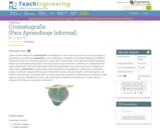
Los estudiantes usan la cromatografía para separar los componentes de la tinta.
- Subject:
- Applied Science
- Engineering
- Material Type:
- Activity/Lab
- Provider:
- TeachEngineering
- Provider Set:
- Sprinkles
- Date Added:
- 01/01/2015

Los estudiantes usan la cromatografía para separar los componentes de la tinta.

This article provides an overview of culturally responsive teaching and highlights resources for more information.

Using a website simulation tool, students build on their understanding of random processes on networks to interact with the graph of a social network of individuals and simulate the spread of a disease. They decide which two individuals on the network are the best to vaccinate in an attempt to minimize the number of people infected and "curb the epidemic." Since the results are random, they run multiple simulations and compute the average number of infected individuals before analyzing the results and assessing the effectiveness of their vaccination strategies.
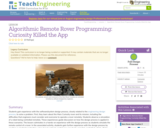
Students gain experience with the software/system design process, closely related to the engineering design process, to solve a problem. First, they learn about the Mars Curiosity rover and its mission, including the difficulties that engineers must consider and overcome to operate a rover remotely. Students observe a simulation of a robot being controlled remotely. These experiences guide discussion on how the design process is applied in these scenarios. The lesson culminates in a hands-on experience with the design process as students simulate the remote control of a rover. In the associated activity, students gain further experience with the design process by creating an Android application using App Inventor to control one aspect of a remotely controlled vehicle. (Note: The lesson requires a LEGO® MINDSTORMS® Education NXT base set.)
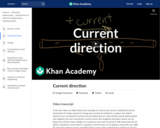
The positive sign for current corresponds to the direction a positive charge would move. In metal wires, current is carried by negatively charged electrons, so the positive current arrow points in the opposite direction the electrons move. This has been the sign convention for 270 years, ever since Ben Franklin named electric charges with + and - signs. This convention came about 150 years before the discovery of the electron. Created by Willy McAllister.

Students pretend they are agricultural engineers during the colonial period and design a miniature plow that cuts through a "field" of soil. They are introduced to the engineering design process and learn of several famous historical figures who contributed to plow design.

This textbook offers a full 7-week college undergraduate/graduate course on cybersecurity risk quantification. A companion Excel-based toolkit with models is included and available for download in the book's resource section.
No prior experience with risk quantification is required.
The course is divided into seven modules. Students are introduced to basic and advanced methods and models for quantifying cyber risk. Students will perform a risk analysis and present their findings in week 7. In module 1, they are given background information for the course project and their first basic tool for quantifying risk. In module 2, they learn how to analyze vulnerability data and receive another tool to complete that work. In module 3, they will perform an attack analysis based on a scenario they will develop, and they are given their first model to quantify that risk. In module 4, they are given several tools and a fully functional FAIR-compliant model, and they will quantify risk in financial terms. In module 5, they are given two advanced models: a probability tree and a Bayesian Inference model. In module 6 students focus on best practices for present their results and communiating risk. In module 7, students deliver their analysis.
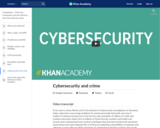
Google Security Princess Parisa Tabriz and Jenny Martin from Symantec introduce the most common types of cybercrime, including viruses, malware, DDOS attacks and phishing scams.
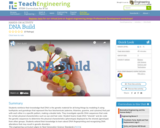
Students reinforce their knowledge that DNA is the genetic material for all living things by modeling it using toothpicks and gumdrops that represent the four biochemicals (adenine, thiamine, guanine, and cytosine) that pair with each other in a specific pattern, making a double helix. They investigate specific DNA sequences that code for certain physical characteristics such as eye and hair color. Student teams trade DNA "strands" and de-code the genetic sequences to determine the physical characteristics (phenotype) displayed by the strands (genotype) from other groups. Students extend their knowledge to learn about DNA fingerprinting and recognizing DNA alterations that may result in genetic disorders.

Students perform DNA forensics using food coloring to enhance their understanding of DNA fingerprinting, restriction enzymes, genotyping and DNA gel electrophoresis. They place small drops of different food coloring ("water-based paint") on strips of filter paper and then place one paper strip end in water. As water travels along the paper strips, students observe the pigments that compose the paint decompose into their color components. This is an example of the chromatography concept applied to DNA forensics, with the pigments in the paint that define the color being analogous to DNA fragments of different lengths.
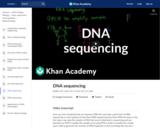
Introduction to DNA sequencing.
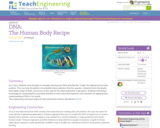
As a class, students work through an example showing how DNA provides the "recipe" for making our body proteins. They see how the pattern of nucleotide bases (adenine, thymine, guanine, cytosine) forms the double helix ladder shape of DNA, and serves as the code for the steps required to make genes. They also learn some ways that engineers and scientists are applying their understanding of DNA in our world.

Overview of DNA and chromatin regulation.
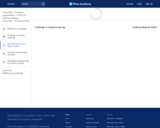
The DOM (Document Object Model)

In this interactive activity from the Building Big Web site, investigate dams in distress and decide if they should be repaired, removed, or left alone.
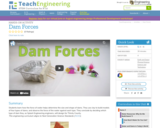
Students learn how the force of water helps determine the size and shape of dams. They use clay to build models of four types of dams, and observe the force of the water against each type. They conclude by deciding which type of dam they, as Splash Engineering engineers, will design for Thirsty County.
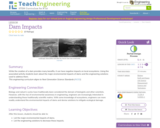
While the creation of a dam provides many benefits, it can have negative impacts on local ecosystems. Students learn about the major environmental impacts of dams and the engineering solutions used to address them.

Students conduct Internet research to investigate the purpose and current functioning status of some of the largest dams throughout the world. They investigate the success or failure of eight dams and complete a worksheet. While researching the dams, they also gain an understanding of the scale of these structures by recording and comparing their reservoir capacities. Students come to understand that dams, like all engineered structures, have a finite lifespan and require ongoing maintenance and evaluation for their usefulness.
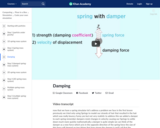
Now we add a damper to our spring.
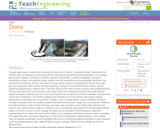
Through eight lessons, students are introduced to many facets of dams, including their basic components, the common types (all designed to resist strong forces), their primary benefits (electricity generation, water supply, flood control, irrigation, recreation), and their importance (historically, currently and globally). Through an introduction to kinetic and potential energy, students come to understand how dams generate electricity. They learn about the structure, function and purpose of locks, which involves an introduction to Pascal's law, water pressure and gravity. Other lessons introduce students to common environmental impacts of dams and the engineering approaches to address them. They learn about the life cycle of salmon and the many engineered dam structures that aid in their river passage, as they think of their own methods and devices that could help fish migrate past dams. Students learn how dams and reservoirs become part of the Earth's hydrologic cycle, focusing on the role of evaporation. To conclude, students learn that dams do not last forever; they require ongoing maintenance, occasionally fail or succumb to "old age," or are no longer needed, and are sometimes removed. Through associated hands-on activities, students track their personal water usage; use clay and plastic containers to model and test four types of dam structures; use paper cups and water to learn about water pressure and Pascal's Law; explore kinetic energy by creating their own experimental waterwheel from two-liter plastic bottles; collect and count a stream's insects to gauge its health; play an animated PowerPoint game to quiz their understanding of the salmon life cycle and fish ladders; run a weeklong experiment to measure water evaporation and graph their data; and research eight dams to find out and compare their original purposes, current status, reservoir capacity and lifespan. Woven throughout the unit is a continuing hypothetical scenario in which students act as consulting engineers with a Splash Engineering firm, assisting Thirsty County in designing a dam for Birdseye River.